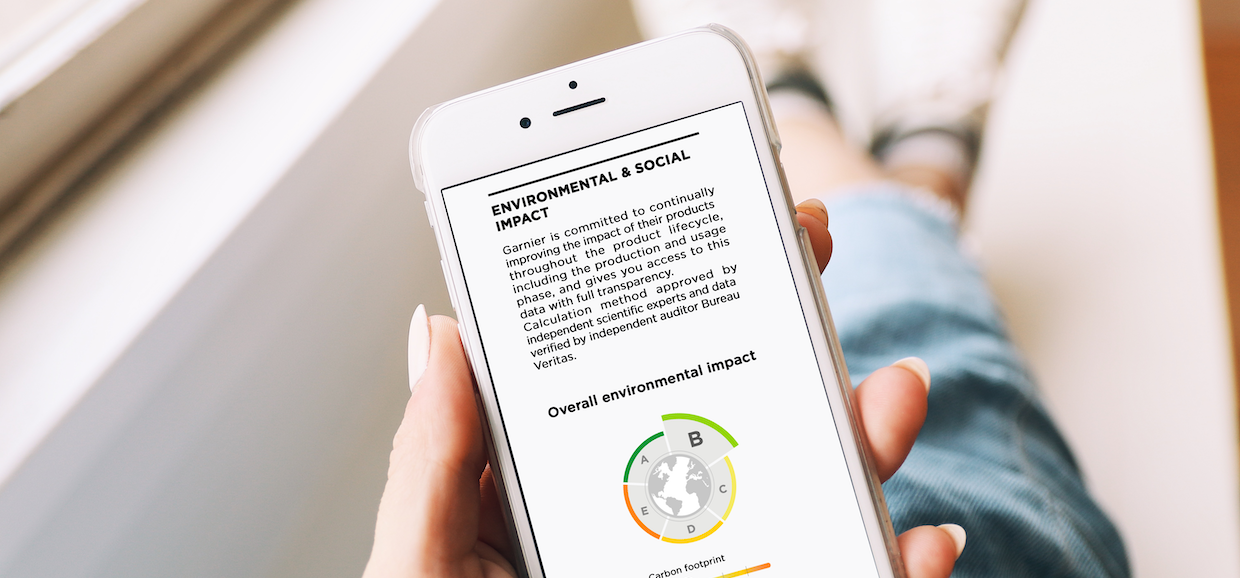L’Oréal USA introduces consumer-facing environmental labeling
L’Oréal USA has introduced a new consumer-facing environmental label feature to offer customers more agency in choosing eco-friendly products.
The initiative, called Product Impact Labeling System (PILS), was first launched in France in 2020 with the Garnier brand and provides customers with the relative environmental impact of a product compared to other L’Oréal products in the same category. Products are ranked on a scale from A to E by considering 14 planetary impact factors such as greenhouse gas emissions, water scarcity, ocean acidification and impact on biodiversity. Grades are also based on every stage of a product’s life cycle, from its ingredients to its disposal. That includes its packaging, manufacturing process and transport. PILS scores are displayed on product information labels just below the ingredient list. The plan is to eventually expand them to retail partner sites and QR codes on packages for people to scan and read. Currently, they’re available for Garnier only. In 2023, products by L’Oréal Paris, Kiehl’s, CeraVe and Redkin will also feature them.
“Consumers are more interested in agency and how they can be actively involved in the process,” said Marissa Pagnani McGowan, chief sustainability officer for L’Oréal North America. “If you ask anyone, in choosing between two equally [priced] things, the more sustainable option would be more appealing. But it is hard to get good, reliable information that is science-based audited and tested, helping you to make [informed] decisions.”
According to McGowan, the PILS feature is based on an internal tool L’Oréal developed in 2017 called the Sustainable Product Optimization Tool, which helps product developers when creating eco-friendly products. The tool, which is a software program, was developed in coordination with Ernst & Young and Quantis, which helped build out out the methodology and functionality of the device. It ranks various criteria, like how much water is used in production, on a scale of zero to 10. The baseline for assigning products an A to E grade within PILS was determined in 2020, with the 10% of products with the lowest footprint per user dose categorized as Class A and the 10% with the highest footprint classified as Class E. The remaining products are assigned to either category B, C or D.
“An ongoing challenge is turning a lifecycle assessment, which is very complex, into something simple to understand. The way we try to do that is to say that, based on our product mix and our lifecycle analysis, we’re scoring products [a certain way],” she said. “The consumers have been quite receptive to it. Do they understand every aspect of it? I’m not sure they even need to. But they understand that the science-based analysis, the lifecycle analysis and planetary boundaries guidance is driving [any given] score.”
L’Oréal is not the only beauty brand to create an environmental labeling system. In March 2021, skin-care brand Cocokind debuted environmental labeling on its outer packaging called “Sustainability Facts,” which was modeled after a nutrition label. Cocokind used the Department of Energy’s Life Cycle Inventory Database to determine its carbon footprint and worked with Carbon Calories to validate all the featured information. Fashion brands have also sought to provide sustainability labels, but not without pitfalls. In July, a Quartz investigation found that H&M regularly misrepresented its products’ environmental impact. Quartz found that hundreds of products were shown to be more sustainable than they were. According to L’Oréal, the independent auditor Bureau Veritas has verified the application of L’Oréal’s methodology and the accuracy of its data, issuing a “favorable assessment” in March 2022. L’Oréal’s methodology also aligns with the European Commission’s Product Environmental Performance recommendations.
Alongside the announcement, L’Oréal USA revealed the findings of a new study conducted in partnership with Morning Consult, which surveyed 2,000 American adults. Some key findings included that most Americans are concerned with at least one of the pre-determined environmental impacts. Human destruction of various environments is the most recognized issue, at over 50%, followed by water scarcity at 43%, air pollution like dust and dirt at 37%, and ozone depletion at 35%, according to the study. Additionally, 54% of Americans expect to find information about sustainability-related factors on company websites.
“The survey results show that consumers have clear expectations for sustainability,” said Sanford Browne, president of research and innovation for L’Oréal North America. “To meet their expectations, we set action plans to improve the environmental profile of lower-ranked products. By 2030, our goal is for 100% of our products to incorporate into their design improvements in formulas, production, packaging and other aspects that help reduce their impact compared to previous generations of products.”
The PILS system is unlikely to be the last effort by L’Oréal or the beauty industry to tackle consumer-facing environmental transparency. In February, L’Oréal Group joined 50 other cosmetic and personal care companies, like Clarins, Colgate-Palmolive and Beiersdorf, to create an EcoBeautyScore Consortium. The aim is to develop an industry-wide environmental impact assessment and scoring system for cosmetic products. A foot-printing and scoring prototype is targeted for the end of 2022, providing the environmental scoring for a selection of product categories, at first. Independent parties will then verify it. According to previous Glossy reporting, the fashion industry has looked to its own version.
“We’re active participants in the EcoBeautyScore Consortium [to develop] an EcoBeauty scoring system. As that becomes available, we have committed ourselves to bring apples-to-apples comparisons between competitor products,” McGowan said.





